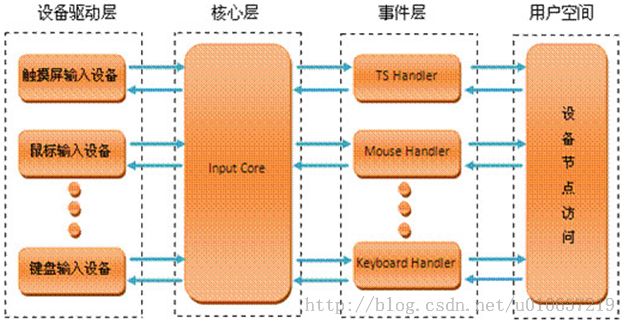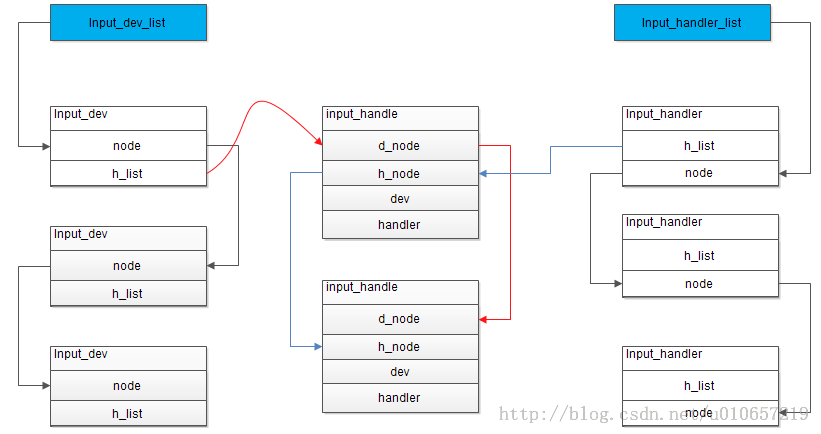Linux输入系统
输入系统简介:
1.统一了物理形态各异的相似的输入设备的处理功能。2.提供了用于分发输入报告给用户应用程序的简单的事件接口。3.抽取出了输入驱动程序的通用部分,简化了驱动,并引入了一致性。
现在 Android、X windows、qt等众多应用对于linux系统中键盘、鼠标、触摸屏等输入设备的支持都通过、或越
来越倾向于标准的input输入子系统。所以好好的分析下input子系统还是很有必要的。
input输入子系统框架
上图来源于网上但确实很系统的描述了linux输入系统的整体构架。从上图可以看出输入子系统由输入设备驱动(input device driver),输入子系统核心层( Input Core ),事件处理层(input event driver)三部份组成。
输入事件是通过: input driver -> Input core -> Event handler -> userspace 到达用户空间传给应用程序,如上图所示!
下面再来看看内核的输入子系统驱动的构架图:
注意:keyboard.c不会在/dev/input下产生节点,而是作为ttyn终端(不包括串口终端)的输入。
在linux内核中,input设备用input_dev结构体描述,使用input子系统实现输入设备驱动的时候,驱动的核心工
作是向系统报告按键、触摸屏、键盘、鼠标等输入事件(event,通过input_event结构体描述),一再需要关心文件操作接口,因为input子系统已经完成了文件操作接口。驱动报告的事件经过InputCore和EventHandler最终到达用户空间。现在了解了input子系统的基本思想,下面来看一下input子系统的3个基本的数据结构:
struct input_dev {
const char *name; //名称
const char *phys; //设备在系统中的物理路径
const char *uniq; //设备唯一识别符
struct input_id id; //设备ID,包含总线ID(PCI、USB)、厂商ID,与input_handler匹配的时会用到
unsigned long evbit[BITS_TO_LONGS(EV_CNT)]; //支持的所有事件类型
unsigned long keybit[BITS_TO_LONGS(KEY_CNT)]; //支持的键盘事件
unsigned long relbit[BITS_TO_LONGS(REL_CNT)]; //支持的鼠标相对值事件
unsigned long absbit[BITS_TO_LONGS(ABS_CNT)]; //支持的鼠标绝对值事件
unsigned long mscbit[BITS_TO_LONGS(MSC_CNT)]; //支持的其它事件类型
unsigned long ledbit[BITS_TO_LONGS(LED_CNT)]; //支持的LED灯事件
unsigned long sndbit[BITS_TO_LONGS(SND_CNT)]; //支持的声效事件
unsigned long ffbit[BITS_TO_LONGS(FF_CNT)]; //支持的力反馈事件
unsigned long swbit[BITS_TO_LONGS(SW_CNT)]; //支持的开关事件
unsigned int keycodemax; //keycode表的大小
unsigned int keycodesize; //keycode表中元素个数
void *keycode; //设备的键盘表
int (*setkeycode)(struct input_dev *dev, int scancode, int keycode);//配置keycode表
int (*getkeycode)(struct input_dev *dev, int scancode, int *keycode);//获取keycode表
struct ff_device *ff;
unsigned int repeat_key;//保存上一个键值
struct timer_list timer;
int sync;
int abs[ABS_MAX + 1]; //绝对坐标上报的当前值
int rep[REP_MAX + 1]; //这个参数主要是处理重复按键,后面遇到再讲
unsigned long key[BITS_TO_LONGS(KEY_CNT)]; //按键有两种状态,按下和抬起,这个字段就是记录这两个状态。
unsigned long led[BITS_TO_LONGS(LED_CNT)];
unsigned long snd[BITS_TO_LONGS(SND_CNT)];
unsigned long sw[BITS_TO_LONGS(SW_CNT)];
int absmax[ABS_MAX + 1]; //绝对坐标的最大值
int absmin[ABS_MAX + 1]; //绝对坐标的最小值
int absfuzz[ABS_MAX + 1];
int absflat[ABS_MAX + 1];
//操作接口
int (*open)(struct input_dev *dev);
void (*close)(struct input_dev *dev);
int (*flush)(struct input_dev *dev, struct file *file);
int (*event)(struct input_dev *dev, unsigned int type, unsigned int code, int value);
struct input_handle *grab; //当前使用的handle
spinlock_t event_lock;
struct mutex mutex;
unsigned int users;
int going_away;
struct device dev;
struct list_head h_list; //h_list是一个链表头,用来把handle挂载在这个上
struct list_head node; //这个node是用来连到input_dev_list上的
};
// input_dev->evbit表示设备支持的事件类型,可以是下列值的组合
#define EV_SYN 0x00 //同步事件
#define EV_KEY 0x01 //绝对二进制值,如键盘或按钮
#define EV_REL 0x02 //绝对结果,如鼠标设备
#define EV_ABS 0x03 //绝对整数值,如操纵杆或书写板
#define EV_MSC 0x04 //其它类
#define EV_SW 0x05 //开关事件
#define EV_LED 0x11 //LED或其它指示设备
#define EV_SND 0x12 //声音输出,如蜂鸣器
#define EV_REP 0x14 //允许按键自重复
#define EV_FF 0x15 //力反馈
#define EV_PWR 0x16 //电源管理事件
include/linux/input.h中定义了支持的类型
struct input_handler {
void *private;
void (*event)(struct input_handle *handle, unsigned int type, unsigned int code, int value);
int (*connect)(struct input_handler *handler, struct input_dev *dev, const struct input_device_id *id);
void (*disconnect)(struct input_handle *handle);
void (*start)(struct input_handle *handle);
const struct file_operations *fops;
int minor; //次设备号
const char *name;
const struct input_device_id *id_table;
const struct input_device_id *blacklist;
struct list_head h_list; //h_list是一个链表头,用来把handle挂载在这个上
struct list_head node; //这个node是用来连到input_handler_list上的
};
struct input_handle {
void *private;
int open;
const char *name;
struct input_dev *dev; //指向input_dev
struct input_handler *handler; //指向input_handler
struct list_head d_node; //连到input_dev的h_list上
struct list_head h_node; //连到input_handler的h_list上
};
如下图代表了input_dev,input_handler,input_handle,3者之间的关系。一类handler可以和多个硬件设备相关联,一个硬件设备可以和多个handler相关联。例如:一个触摸屏设备可以作为一个event设备,作为一个鼠标设备,也可以作为一个触摸设备,所以一个设备需要与多个平台驱动进行连接。而一个平台驱动也不只为一个设备服务,一个触摸平台驱动可能要为A,B,C3个触摸设备提供上层驱动,所以需要这样一对多的连接。
input_handle的dev 和handler域分别指向与其相关联的input_dev和input_handler.input_handle是input_dev到input_handler的中间桥梁。
input字符设备的注册
static int __init input_init(void)
{
int err;
input_init_abs_bypass();
/*创建一个类input_class*/
err = class_register(&input_class);
if (err) {
printk(KERN_ERR "input: unable to register input_dev class/n");
return err;
}
/*在/proc下创建入口项*/
err = input_proc_init();
if (err)
goto fail1;
/*注册设备号INPUT_MAJOR的设备,记住input子系统的设备的主设备号都是13,即INPUT_MAJOR为13,并与input_fops相关联*/
err = register_chrdev(INPUT_MAJOR, "input", &input_fops);
if (err) {
printk(KERN_ERR "input: unable to register char major %d", INPUT_MAJOR);
goto fail2;
}
return 0;
fail2: input_proc_exit();
fail1: class_unregister(&input_class);
return err;
}
subsys_initcall(input_init);
static const struct file_operations input_fops = {
.owner = THIS_MODULE,
.open = input_open_file,
.llseek = noop_llseek,
};
打开输入设备文件时,input_open_file函数将会被调用,下面我们来看看这个函数:
static int input_open_file(struct inode *inode, struct file *file)
{
struct input_handler *handler;
const struct file_operations *old_fops, *new_fops = NULL;
int err;
err = mutex_lock_interruptible(&input_mutex);
if (err)
return err;
/* No load-on-demand here? */
handler = input_table[iminor(inode) >> 5];
if (handler)
new_fops = fops_get(handler->fops);
mutex_unlock(&input_mutex);
/*
* That's _really_ odd. Usually NULL ->open means "nothing special",
* not "no device". Oh, well...
*/
if (!new_fops || !new_fops->open) {
fops_put(new_fops);
err = -ENODEV;
goto out;
}
old_fops = file->f_op;
file->f_op = new_fops;
err = new_fops->open(inode, file);
if (err) {
fops_put(file->f_op);
file->f_op = fops_get(old_fops);
}
fops_put(old_fops);
out:
return err;
}
上面这个函数是linux的精髓之所在,因为input.c是抽象的输入设备,在 input_open_file中并不知道怎么打开各种各样五发八门的输入设备,所以将打开的过程交给增对特定的设备实现的handler。
输入设备input_dev的注册
int input_register_device(struct input_dev *dev)
{
static atomic_t input_no = ATOMIC_INIT(0);
struct input_handler *handler;
const char *path;
int error;
__set_bit(EV_SYN, dev->evbit);
/*
* If delay and period are pre-set by the driver, then autorepeating
* is handled by the driver itself and we don't do it in input.c.
*/
init_timer(&dev->timer);
/*
*rep主要是处理重复按键,如果没有定义dev->rep[REP_DELAY]和dev->rep[REP_PERIOD],
*则将其赋值为默认值。dev->rep[REP_DELAY]是指第一次按下多久算一次,这里是250ms,
*dev->rep[REP_PERIOD]指如果按键没有被抬起,每33ms算一次。
*/
if (!dev->rep[REP_DELAY] && !dev->rep[REP_PERIOD]) {
dev->timer.data = (long) dev;
dev->timer.function = input_repeat_key;
dev->rep[REP_DELAY] = 250;
dev->rep[REP_PERIOD] = 33;
}
/*如果dev没有定义getkeycode和setkeycode,则赋默认值。他们的作用一个是获得键的扫描码,一个是设置键的扫描码*/
if (!dev->getkeycode)
dev->getkeycode = input_default_getkeycode;
if (!dev->setkeycode)
dev->setkeycode = input_default_setkeycode;
dev_set_name(&dev->dev, "input%ld",
(unsigned long) atomic_inc_return(&input_no) - 1);
/*将input_dev封装的dev注册到sysfs*/
error = device_add(&dev->dev);
if (error)
return error;
path = kobject_get_path(&dev->dev.kobj, GFP_KERNEL);
printk(KERN_INFO "input: %s as %s/n",
dev->name ? dev->name : "Unspecified device", path ? path : "N/A");
kfree(path);
error = mutex_lock_interruptible(&input_mutex);
if (error) {
device_del(&dev->dev);
return error;
}
/*将input_dev挂在input_dev_list上*/
list_add_tail(&dev->node, &input_dev_list);
/*匹配所有的input_handler,这个就是刚才那幅图里的一个设备对应多个handler的由来*/
list_for_each_entry(handler, &input_handler_list, node)
input_attach_handler(dev, handler);
input_wakeup_procfs_readers();
mutex_unlock(&input_mutex);
return 0;
}
input_attach_handler实际上是找到相关联的handler,并与注册的input_dev相关联的过程:
static int input_attach_handler(struct input_dev *dev, struct input_handler *handler)
{
const struct input_device_id *id;
int error;
/*handler有一个黑名单,如果存在黑名单,并且这个id匹配就退出*/
if (handler->blacklist && input_match_device(handler->blacklist, dev))
return -ENODEV;
/*匹配id,实现在下边可以看到*/
id = input_match_device(handler->id_table, dev);
if (!id)
return -ENODEV;
/*如果匹配,则调用具体的handler的connect函数*/
error = handler->connect(handler, dev, id);
if (error && error != -ENODEV)
printk(KERN_ERR
"input: failed to attach handler %s to device %s, "
"error: %d/n",
handler->name, kobject_name(&dev->dev.kobj), error);
return error;
}
static const struct input_device_id *input_match_device(struct input_handler *handler,
struct input_dev *dev)
{
const struct input_device_id *id;
int i;
for (id = handler->id_table; id->flags || id->driver_info; id++) {
pr_err("xjldebug id->flags =%d id->driver_info =%d \n",id->flags ,id->driver_info);
if (id->flags & INPUT_DEVICE_ID_MATCH_BUS)
if (id->bustype != dev->id.bustype)
continue;
if (id->flags & INPUT_DEVICE_ID_MATCH_VENDOR)
if (id->vendor != dev->id.vendor)
continue;
if (id->flags & INPUT_DEVICE_ID_MATCH_PRODUCT)
if (id->product != dev->id.product)
continue;
if (id->flags & INPUT_DEVICE_ID_MATCH_VERSION)
if (id->version != dev->id.version)
continue;
MATCH_BIT(evbit, EV_MAX);
MATCH_BIT(keybit, KEY_MAX);
MATCH_BIT(relbit, REL_MAX);
MATCH_BIT(absbit, ABS_MAX);
MATCH_BIT(mscbit, MSC_MAX);
MATCH_BIT(ledbit, LED_MAX);
MATCH_BIT(sndbit, SND_MAX);
MATCH_BIT(ffbit, FF_MAX);
MATCH_BIT(swbit, SW_MAX);
if (!handler->match || handler->match(handler, dev)){
pr_err("xjl debug !\n");
return id;
}
}
return NULL;
}
若id->driver_info为1且handler->match为空,那么这样的handler可以匹配任何设备!
/*
* Create new evdev device. Note that input core serializes calls
* to connect and disconnect so we don't need to lock evdev_table here.
*/
static int evdev_connect(struct input_handler *handler, struct input_dev *dev,
const struct input_device_id *id)
{
struct evdev *evdev;
int minor;
int error;
/*
*首先补充几个知识点:
*static struct input_handler *input_table[8];
*#define INPUT_DEVICES 256
*一共有8个input_handler,对应256个设备,所以一个handler对应32个设备。
*这个问题在我参加的一次linux驱动的面试中被问到,当时真是汗啊!!!
*static struct evdev *evdev_table[EVDEV_MINORS];
*#define EVDEV_MINORS 32
*evdev理论上可对应32个设备,其对应的设备节点一般位于/dev/input/event0~/dev/input/event4
*下边的for循环,在evdev_table数组中找一个未使用的地方
*/
for (minor = 0; minor < EVDEV_MINORS; minor++)
if (!evdev_table[minor])
break;
if (minor == EVDEV_MINORS) {
printk(KERN_ERR "evdev: no more free evdev devices/n");
return -ENFILE;
}
/*下边的代码是为每一个匹配的设备分配一个evdev结构体,并对成员进行初始化*/
evdev = kzalloc(sizeof(struct evdev), GFP_KERNEL);
if (!evdev)
return -ENOMEM;
INIT_LIST_HEAD(&evdev->client_list);
spin_lock_init(&evdev->client_lock);
mutex_init(&evdev->mutex);
init_waitqueue_head(&evdev->wait);
snprintf(evdev->name, sizeof(evdev->name), "event%d", minor);
evdev->exist = 1;
evdev->minor = minor;
evdev->handle.dev = input_get_device(dev);
evdev->handle.name = evdev->name;
evdev->handle.handler = handler;
evdev->handle.private = evdev;
dev_set_name(&evdev->dev, evdev->name);
evdev->dev.devt = MKDEV(INPUT_MAJOR, EVDEV_MINOR_BASE + minor);
evdev->dev.class = &input_class; /*调用函数创建字符设备节点*/
evdev->dev.parent = &dev->dev;
evdev->dev.release = evdev_free;
/**/
device_initialize(&evdev->dev);
/*
*input_register_handle完成的主要功能是:
*list_add_tail_rcu(&handle->d_node, &dev->h_list);
*list_add_tail(&handle->h_node, &handler->h_list);
*/
error = input_register_handle(&evdev->handle);
if (error)
goto err_free_evdev;
/*evdev_install_chrdev完成的功能是evdev_table[evdev->minor]=evdev;*/
error = evdev_install_chrdev(evdev);
if (error)
goto err_unregister_handle;
error = device_add(&evdev->dev);
if (error)
goto err_cleanup_evdev;
return 0;
。。。。。。。。。。
}
输入事件的report
struct input_event {
struct timeval time; //事件发生的时间
__u16 type; //事件类型
__u16 code; //子事件
__s32 value; //事件的value
};
struct evdev_client {
struct input_event buffer[EVDEV_BUFFER_SIZE]; //可以同时管理EVDEV_BUFFER_SIZE(64)个事件
int head; //存储事件从head开始
int tail; //取出事件从tail开始
spinlock_t buffer_lock; /* protects access to buffer, head and tail */
struct fasync_struct *fasync; //异步通知事件发生
struct evdev *evdev; //指向本evdev_client归属的evdev
struct list_head node; //用于挂载到evdev的链表头client_list上
};
static struct input_handler evdev_handler = {
.event = evdev_event, //向系统报告input事件,系统通过read方法读取
.connect = evdev_connect, //和input_dev匹配后调用connect构建
.disconnect = evdev_disconnect,
.fops = &evdev_fops, //event设备文件的操作方法
.minor = EVDEV_MINOR_BASE,//次设备号基准值
.name = "evdev",
.id_table = evdev_ids, //匹配规则
};
这里的次设备号是EVDEV_MINOR_BASE(64),也就是说evdev_handler所表示的设备文件范围(13,64)~(13,64+32)。
如下一个结构体:evdev_handler匹配所有设备。
static const struct input_device_id evdev_ids[] = {
{ .driver_info = 1 }, /* Matches all devices */
{ }, /* Terminating zero entry */
};
看一下这张图会对上边的结构有一个清楚的认知了:
这个是evdev_handler是fops,下面的讲解中会用到其中的open,read函数。
在驱动程序中我们会调用input_report_abs等函数:
设备驱动通过宏set_bit()告诉input子系统它支持哪些事件,如下所示
set_bit(EV_KEY, input_dev->keybit); //EV_KEY事件支持的事件码
struct input_dev中有两个成员,一个是unsigned long evbit,一个是unsigned long keybit,分别用来表示设备所支持的事件类型和按键类型。
用于报告EV_KEY、EV_REL、EV_ABS、EV_FF、EV_SW等事件的函数有:
void input_report_key(struct input_dev *dev, unsigned int code, int value)
void input_report_rel(struct input_dev *dev, unsigned int code, int value)
void input_report_abs(struct input_dev *dev, unsigned int code, int value)
void input_report_ff_status(struct input_dev *dev, unsigned int code, int value)
void input_report_switch(struct input_dev *dev, unsigned int code, int value)
如果你觉得麻烦,你也可以只记住1个函数(因为上述函数都是通过它实现的)
void input_event(struct input_dev *dev, unsigned int type, unsigned int code, int value)
相关参数介绍:
code:
事件的代码。如果事件的类型是EV_KEY,该代码code为设备键盘代码。代码值0-127为键盘上的按键代码,0x110-0x116为鼠标上按键代码,其中0x110(BTN_LEFT)为鼠标左键,0x111(BTN_RIGHT)为鼠标右键,0x112(BTN_MIDDLE)为鼠标中键。其它代码含义请参看include/linux/input.h文件。
value:
事件的值。如果事件的类型是EV_KEY,当按键按下时值为1,松开时值为0.
事件报告完毕后,设备驱动需要使用input_sync函数告诉输入子系统一个完整的报告已经发送。
void input_sync(struct input_dev *dev)
{
input_event(dev,EV_SYN,SYN_REPORT,0);
}
这一点在鼠标移动处理中很重要,因为鼠标坐标的X分量和Y分量是分开传送的,需要利用input_sync函数来同步。
跟踪input_event如下:
void input_event(struct input_dev *dev,
unsigned int type, unsigned int code, int value)
{
unsigned long flags;
if (is_event_supported(type, dev->evbit, EV_MAX)) {
spin_lock_irqsave(&dev->event_lock, flags);
/*利用输入值调正随机数产生器*/
add_input_randomness(type, code, value);
input_handle_event(dev, type, code, value);
spin_unlock_irqrestore(&dev->event_lock, flags);
}
}
static void input_handle_event(struct input_dev *dev,
unsigned int type, unsigned int code, int value)
{
int disposition = INPUT_IGNORE_EVENT;
switch (type) {
。。。。。。。。。。。。。。。。
if (disposition != INPUT_IGNORE_EVENT && type != EV_SYN)
dev->sync = 0;
if ((disposition & INPUT_PASS_TO_DEVICE) && dev->event)
dev->event(dev, type, code, value);
if (disposition & INPUT_PASS_TO_HANDLERS)
input_pass_event(dev, type, code, value);
}
如果该事件需要input device来完成,就会将disposition设置成INPUT_PASS_TO_DEVICE,如果需要input handler来完成,就会将disposition设置成INPUT_PASS_TO_DEVICE,如果需要两者都参与,则将disposition设置成INPUT_PASS_TO_ALL。跟踪input_pass_event如下:
static void input_pass_event(struct input_dev *dev,
unsigned int type, unsigned int code, int value)
{
struct input_handle *handle;
rcu_read_lock();
/**/
handle = rcu_dereference(dev->grab);
if (handle)
/*如果input_dev的grab指向了一个handle,就用这个handle关联的handler的event,否则遍历整个挂在input_dev的h_list上的handle关联的handler*/
handle->handler->event(handle, type, code, value);
else
list_for_each_entry_rcu(handle, &dev->h_list, d_node)
if (handle->open)
handle->handler->event(handle,
type, code, value);
rcu_read_unlock();
}
比如下边的evdev_handler的evdev_event:
static void evdev_event(struct input_handle *handle,
unsigned int type, unsigned int code, int value)
{
struct evdev *evdev = handle->private;
struct evdev_client *client;
struct input_event event;
do_gettimeofday(&event.time);
event.type = type;
event.code = code;
event.value = value;
rcu_read_lock();
client = rcu_dereference(evdev->grab);
if (client)
/*如果evdev->grab指向一个当前使用的client就将event放到这个client的buffer中,否则放到整个client_list上的client的链表中*/
evdev_pass_event(client, &event);
else
list_for_each_entry_rcu(client, &evdev->client_list, node)
evdev_pass_event(client, &event);
rcu_read_unlock();
wake_up_interruptible(&evdev->wait);
}
static void evdev_pass_event(struct evdev_client *client,
struct input_event *event)
{
/*
* Interrupts are disabled, just acquire the lock
*/
spin_lock(&client->buffer_lock);
/*将event装入client的buffer中,buffer是一个环形缓存区*/
client->buffer[client->head++] = *event;
client->head &= EVDEV_BUFFER_SIZE - 1;
spin_unlock(&client->buffer_lock);
kill_fasync(&client->fasync, SIGIO, POLL_IN);
}
这里总结一下事件的传递过程:首先在驱动层中,调用inport_report_abs,然后他调用了input core层的input_event,input_event调用了input_handle_event对事件进行分派,调用input_pass_event,在这里他会把事件传递给具体的handler层,然后在相应handler的event处理函数中,封装一个event,然后把它投入evdev的那个client_list上的client的事件buffer中,等待用户空间来读取。当用户空间打开设备节点/dev/input/event0~/dev/input/event4的时候,会使用input_fops中的input_open_file()函数,input_open_file()->evdev_open()(如果handler是evdev的话)->evdev_open_device()->input_open_device()->dev->open()。也就是struct file_operations input_fops提供了通用接口,最终会调用具体input_dev的open函数。下边看一下用户程序打开文件时的过程,首先调用了input_open_file:
static int input_open_file(struct inode *inode, struct file *file)
{
struct input_handler *handler;
const struct file_operations *old_fops, *new_fops = NULL;
int err;
lock_kernel();
/* No load-on-demand here? */
/*因为32个input_dev公共一个handler所以低5位应该是相同的*/
handler = input_table[iminor(inode) >> 5];
if (!handler || !(new_fops = fops_get(handler->fops))) {
err = -ENODEV;
goto out;
}
/*
* That's _really_ odd. Usually NULL ->open means "nothing special",
* not "no device". Oh, well...
*/
if (!new_fops->open) {
fops_put(new_fops);
err = -ENODEV;
goto out;
}
/*保存以前的fops,使用相应的handler的fops*/
old_fops = file->f_op;
file->f_op = new_fops;
err = new_fops->open(inode, file);
if (err) {
fops_put(file->f_op);
file->f_op = fops_get(old_fops);
}
fops_put(old_fops);
out:
unlock_kernel();
return err;
}
这里还是假设handler是evdev_handler。
static int evdev_open(struct inode *inode, struct file *file)
{
struct evdev *evdev;
struct evdev_client *client;
/*因为次设备号是从EVDEV_MINOR_BASE开始的*/
int i = iminor(inode) - EVDEV_MINOR_BASE;
int error;
if (i >= EVDEV_MINORS)
return -ENODEV;
error = mutex_lock_interruptible(&evdev_table_mutex);
if (error)
return error;
/*evdev_table一共可容纳32个成员,找到次设备号对应的那个*/
evdev = evdev_table[i];
if (evdev)
get_device(&evdev->dev);
mutex_unlock(&evdev_table_mutex);
if (!evdev)
return -ENODEV;
/*打开的时候创建一个client*/
client = kzalloc(sizeof(struct evdev_client), GFP_KERNEL);
if (!client) {
error = -ENOMEM;
goto err_put_evdev;
}
spin_lock_init(&client->buffer_lock);
/*下边两句的作用就是将evdev和client绑定到一起*/
client->evdev = evdev;
evdev_attach_client(evdev, client);
error = evdev_open_device(evdev);
if (error)
goto err_free_client;
/*将file->private_data指向刚刚建的client,后边会用到的*/
file->private_data = client;
return 0;
err_free_client:
evdev_detach_client(evdev, client);
kfree(client);
err_put_evdev:
put_device(&evdev->dev);
return error;
}
static int evdev_open_device(struct evdev *evdev)
{
int retval;
retval = mutex_lock_interruptible(&evdev->mutex);
if (retval)
return retval;
/*如果设备不存在,返回错误*/
if (!evdev->exist)
retval = -ENODEV;
/*如果是被第一次打开,则调用input_open_device*/
else if (!evdev->open++) {
retval = input_open_device(&evdev->handle);
if (retval)
evdev->open--;
}
mutex_unlock(&evdev->mutex);
return retval;
}
int input_open_device(struct input_handle *handle)
{
struct input_dev *dev = handle->dev;
int retval;
retval = mutex_lock_interruptible(&dev->mutex);
if (retval)
return retval;
if (dev->going_away) {
retval = -ENODEV;
goto out;
}
handle->open++;
if (!dev->users++ && dev->open)
retval = dev->open(dev);
if (retval) {
dev->users--;
if (!--handle->open) {
/*
* Make sure we are not delivering any more events
* through this handle
*/
synchronize_rcu();
}
}
out:
mutex_unlock(&dev->mutex);
return retval;
}
下面是用户进程读取event的底层实现:
static ssize_t evdev_read(struct file *file, char __user *buffer,
size_t count, loff_t *ppos)
{
/*这个就是刚才在open函数中*/
struct evdev_client *client = file->private_data;
struct evdev *evdev = client->evdev;
struct input_event event;
int retval;
if (count < input_event_size())
return -EINVAL;
/*如果client的环形缓冲区中没有数据并且是非阻塞的,那么返回-EAGAIN,也就是try again*/
if (client->head == client->tail && evdev->exist &&
(file->f_flags & O_NONBLOCK))
return -EAGAIN;
/*如果没有数据,并且是阻塞的,则在等待队列上等待吧*/
retval = wait_event_interruptible(evdev->wait,
client->head != client->tail || !evdev->exist);
if (retval)
return retval;
if (!evdev->exist)
return -ENODEV;
/*如果获得了数据则取出来,调用evdev_fetch_next_event*/
while (retval + input_event_size() <= count &&
evdev_fetch_next_event(client, &event)) {
/*input_event_to_user调用copy_to_user传入用户程序中,这样读取完成*/
if (input_event_to_user(buffer + retval, &event))
return -EFAULT;
retval += input_event_size();
}
return retval;
}
static int evdev_fetch_next_event(struct evdev_client *client,
struct input_event *event)
{
int have_event;
spin_lock_irq(&client->buffer_lock);
/*先判断一下是否有数据*/
have_event = client->head != client->tail;
/*如果有就从环形缓冲区的取出来,记得是从head存储,tail取出*/
if (have_event) {
*event = client->buffer[client->tail++];
client->tail &= EVDEV_BUFFER_SIZE - 1;
}
spin_unlock_irq(&client->buffer_lock);
return have_event;
}
int input_event_to_user(char __user *buffer,
const struct input_event *event)
{
/*如果设置了标志INPUT_COMPAT_TEST就将事件event包装成结构体compat_event*/
if (INPUT_COMPAT_TEST) {
struct input_event_compat compat_event;
compat_event.time.tv_sec = event->time.tv_sec;
compat_event.time.tv_usec = event->time.tv_usec;
compat_event.type = event->type;
compat_event.code = event->code;
compat_event.value = event->value;
/*将包装成的compat_event拷贝到用户空间*/
if (copy_to_user(buffer, &compat_event,
sizeof(struct input_event_compat)))
return -EFAULT;
} else {
/*否则,将event拷贝到用户空间*/
if (copy_to_user(buffer, event, sizeof(struct input_event)))
return -EFAULT;
}
return 0;
}
这里总结一下:如果两个进程打开同一个文件,每个进程在打开时都会生成一个evdev_client,evdev_client被挂在evdev的client_list,在handle收到一个事件的时候,会把事件copy到挂在client_list上的所有evdev_client的buffer中。这样所有打开同一个设备的进程都会收到这个消息而唤醒。


